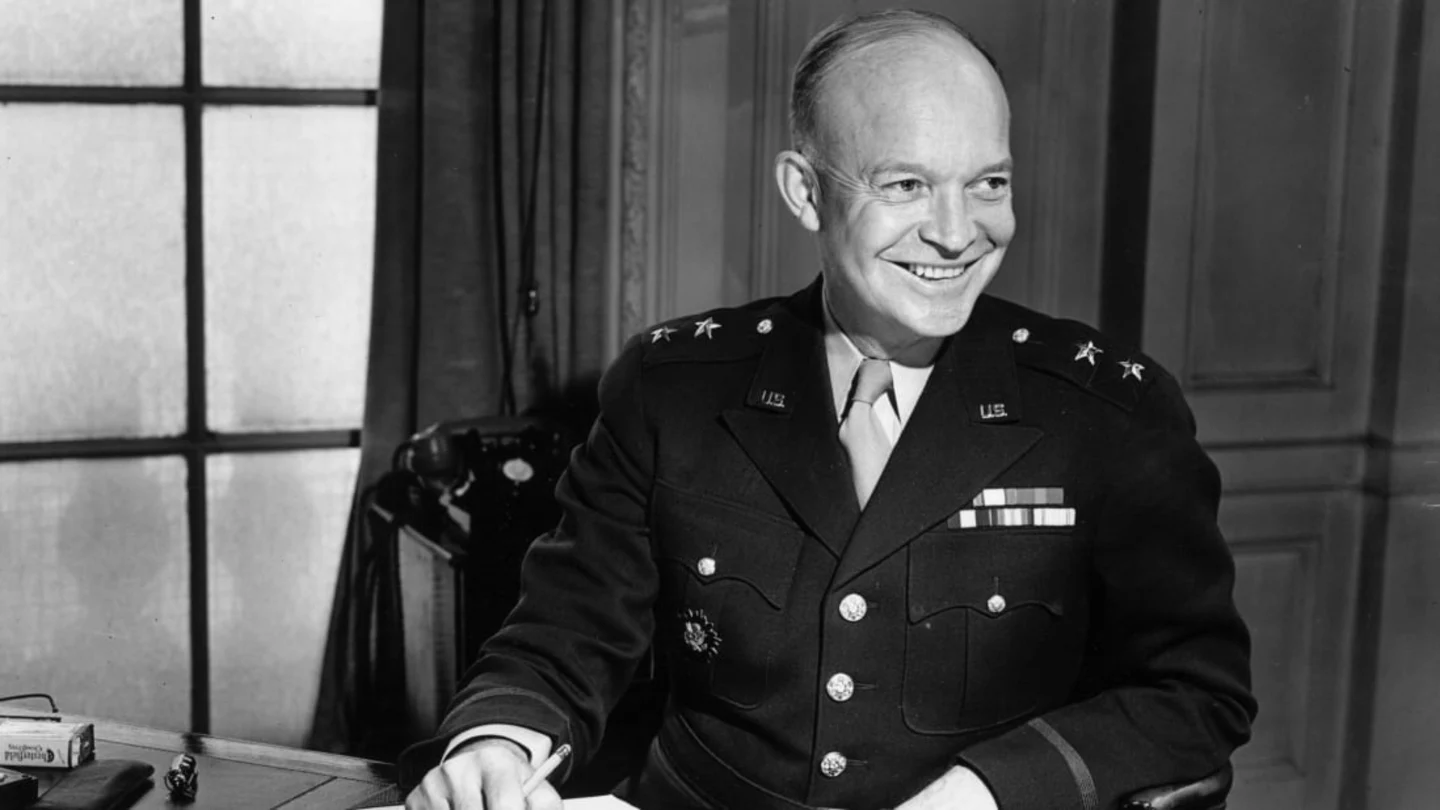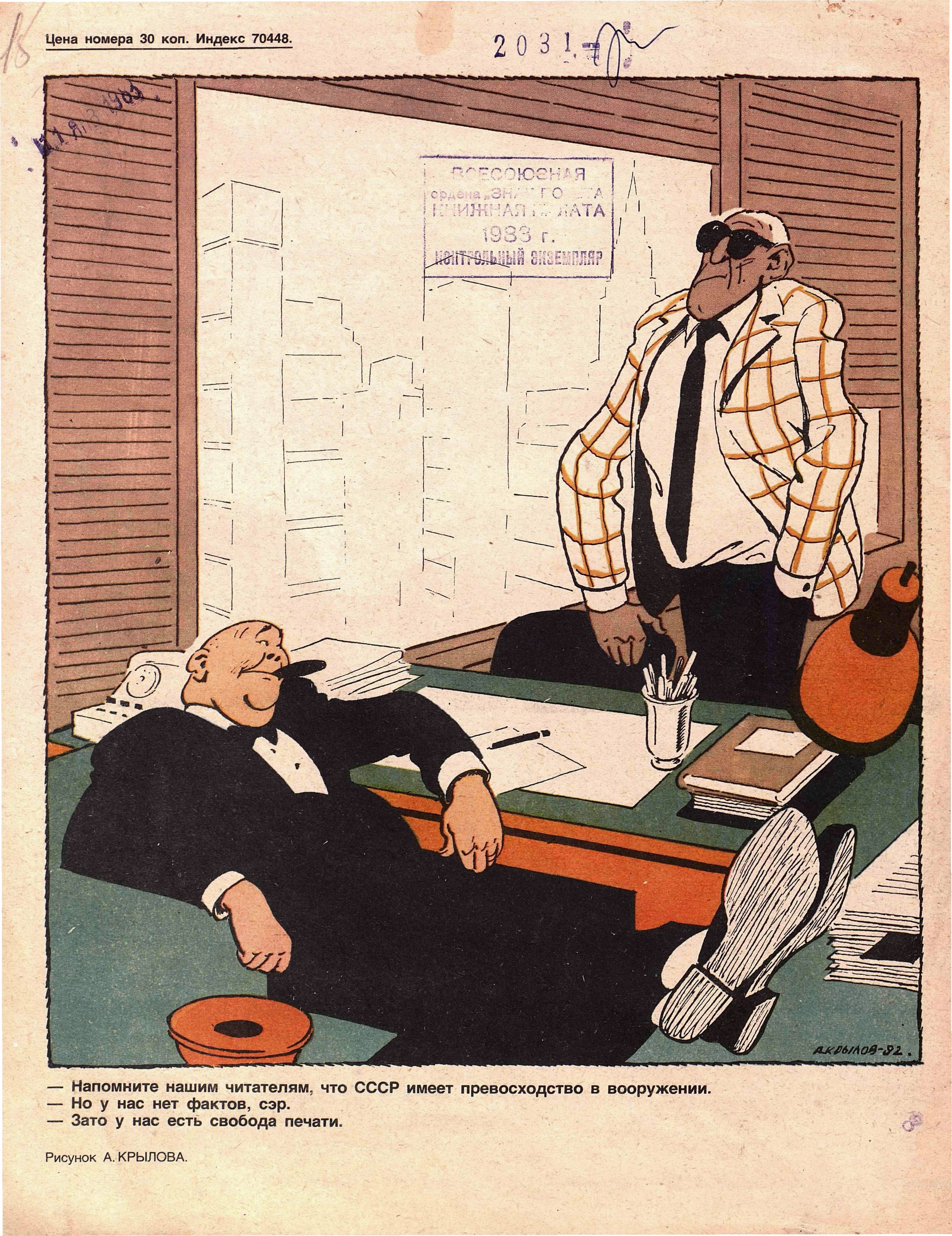The article appears in the “Historian” magazine, written by Alexander Kolpakidi. We added an illustration to better drive home the point about MSM collusion.
US President Dwight Eisenhower was quite far-sighted, but America in his time was not yet mature enough to understand the changed balance of power in the world.
The first timid steps of this president towards “détente” were resolutely opposed by the majority of the American elite, and the CIA twice became an insurmountable obstacle to the president’s path, thwarting his plans.
The first time this happened was due to the myth that America was lagging behind in the number of bombers.
It all started when the experts from the Rand Corporation began to study the vulnerability of the bases of the Strategic Aviation Command. Although the United States had superiority over the USSR in both nuclear weapons and bombers at that time, experts painted a terrifying picture of how a Soviet strike would destroy American strategic aviation on the ground and the United States would remain helpless before the “terrible Russians.”
The CIA was tasked with assessing the power of the Soviet air force. This task was performed in an absolutely amazing way. Intelligence agents had to… estimate the total production area of the aviation plant in Fili and, based on this estimate, calculate the production rate of strategic bombers. American military factories must be somewhat different from ours in terms of the rational use of the land allocated to them. Based on the CIA agents walking around the factory fence, which, in addition to the workshops, enclosed squares, garbage dumps and wastelands, it was concluded that the production of Soviet bombers was growing fantastically.
These “scientifically” based calculations were supported by even more “scientific” observations. On July 3, 1955, the Day of the Air Force, during the aviation parade in Moscow, the American intelligence officers diligently counted the bombers which took part in the celebration. The numbers turned out to be fantastic. The only thing the Americans didn’t realise was that they kept counting the same planes circling in the area of the air parade. This consideration was too primitive for the intelligence aces.
Based on these calculations and observations, the CIA estimated that the USSR would deploy 500 such aircraft by 1960. The terrible data got into the press, and the hysteria that broke out about the “bomber gap” significantly limited Eisenhower’s freedom of manoeuvrer for a while.
– The article continues after the illustration…
♦️♦️♦️
The “Soviet threat” (which nowadays morphed into the “Russian threat”) remained with the USA, constantly whipped into the frenzy among the general public by the “free press”.
Andrey Krylov drew this caricature for the Soviet satirical magazine “Krokodil”, published in issue №2 in 1983.
— Remind our readers that the USSR has a superiority in armaments.
— But we do not have facts, sir…
— On the other hand, we have freedom of press.
♦️♦️♦️
True, this myth was shattered immediately after the U-2 reconnaissance flights over Soviet territory, but this did not happen before the US Congress approved appropriations for the B-52 intercontinental bomber. As the former American ambassador and later a scientist at the influential Brookings Institution R.Garthoff aptly noted later on another occasion, the American military and political leadership too often makes decisions in the military field based on data and conclusions about the intention of the Soviet Union, which uses the principle of the “mirror image”: plans and intentions inherent in the Washington elite are attributed to the opposing side. We also note that the CIA, like that proverbial cashier in a store, invariably makes mistakes in one favour. The one that benefits the military-industrial complex.
No sooner did America start calming down after the “bomber gap”, as the hysteria about the “missile gap” began. However, this time it had some grounds to it. On August 26, 1957, the USSR officially announced the successful test of an intercontinental ballistic missile. Although the United States was only a few months behind in the development of its Atlas ICBM, for the first time Russia took the lead in the arms race. Initially, Washington tried to belittle the Soviet achievement, saying that the Soviet rocket was not even a prototype, but on October 4, 1957, Sputnik 1 was launched into space, which not only opened the space age, but also demonstrated to the whole world the Russian leadership in rocket technology. And once again, it plunged the whole of America into a severe shock from the realisation of his vulnerability. The famous writer Stephen King, at that time a simple schoolboy, paints in vivid colours the typical reaction of an American man in the street to what happened:
“For the first time, I experienced horror – genuine horror, and not an encounter with demons or ghosts living in my imagination – one October day in 1957. I just turned ten. And, as expected, I was in a movie theatre – at the Stratford Theater in downtown Stratford, Connecticut…
…On that Saturday afternoon, when the real horror hit me, it was “Earth against Flying Saucers”…
And just at the moment when in the last part of the film the aliens are preparing to attack the Capitol, the film stopped. The screen went blank. The cinema was packed with children, but strangely enough, everyone was quiet. If you look back to the days of your youth, you will remember that a crowd of kids knows how to express their irritation in many ways if a movie is interrupted or starts late: rhythmic clapping; the great cry of the children’s tribe “We want a movie! We want a movie! We want a movie!”, candy boxes flying into the screen; pipes made of popcorn packets, and many other things. If someone has a firecracker in their pocket since the fourth of July, they will certainly take it out, show it to their friends so that they approve and admire, and then light it and throw it to the ceiling.
But nothing like that happened that October day. And the film didn’t break – they just turned off the projector. And then something unheard of happened: the lights went on in the hall. We sat there, looking around and blinking in the bright light like moles.
The manager came on stage and raised his hand, asking for silence, a completely unnecessary gesture…
* * *
We sat on chairs like mannequins and looked at the manager. He looked worried and sickly, or maybe it was the lighting. We were wondering what kind of disaster had caused him to stop the film at the most tense moment, but then the manager spoke, and the tremor in his voice confused us even more.
“I want to inform you,” he began, “that the Russians have launched a space satellite into orbit around the Earth. They called it… “sputnik”.
The message was met with absolute, deathly silence. A movie theatre full of kids with hedgehogs and ponytails, in jeans and skirts, with Captain Midnight rings, kids who had just recognized Chuck Berry and Little Richard and listened to New York radio stations in the evenings with such bated breath, as if they were signals from another planet. We grew up watching Captain Video and Terry and the Pirates. We admired in the comics how Casey’s character throws a whole bunch of Asians like skittles. We Saw Richard Carlson in “I Led Three Lives” catching dirty communist spies by the thousands. We paid a quarter of a dollar each for the right to see Hugh Marlowe in Earth vs. Flying Saucers, and received this devastating news as a free bonus.”
While the public was in a panic, expecting a nuclear strike and buying up weapons and canned food for nuclear shelters in anticipation of it, three members of the Gaither commission, created at the end of 1957 to analyse the situation of the “bomber gap,” came to the president and insistently demanded that a preventive war be launched against the USSR. As one of his assistants testifies in her diary, the president listened to the proposal very politely and cordially, and then replied: “We cannot start such a war. We don’t have enough bulldozers to shovel bodies off the streets.”
The CIA again became actively involved in assessing the scale of the “missile gap”, and as a result of the collective efforts of the intelligence community, military experts predicted that the USSR would very soon outpace the United States in terms of intercontinental ballistic missiles in a ratio of no less than 15 to 1. The military-industrial complex made money again on the outbreak of a new hysteria — in November 1957, the Joint Chiefs of Staff demanded that $1.5 billion be allocated over the budget for projects to develop long-range guided missiles and strategic aviation. The missile weapons development program has generally taken on an extraordinary character. Speaking in the Senate the same month, the Defence Minister announced a decision to begin production of two medium-range ballistic missiles at once, the Thor and Jupiter, although in reality only one was needed.
Realising more and more that the nuclear missile race was leading to a dead end, Eisenhower sought to normalise relations with Moscow. Hrushchev’s visit to the United States was the first step towards establishing the principle of peaceful coexistence. Soon after, on May 17, 1960, a meeting of the heads of government was to be held in Paris, for which even greater hopes were pinned. However, almost on the eve of this meeting, the intelligence leadership sent a U-2 reconnaissance aircraft into Soviet airspace, which was supposed to cross the entire territory of the USSR. The provocation was particularly offensive and provocative, as it took place on May 1, one of the main Soviet holidays. When the plane piloted by Powers was shot down, Moscow received indisputable evidence of its American affiliation. Hrushchev sarcastically asked in his official speech:
“The question arises, who sent this plane to the Soviet Union? Was it sent with the approval of the Commander-in-Chief of the armed forces of the United States of America, that is, the president, or was this aggressive act committed by militarists from the Pentagon without the president’s knowledge?”

“Soviet Threat!!!”
The 1979 caricature by the Soviet art collective “Kukryniksy”, in which USA screams these words through the NATO loudspeaker.
President Eisenhower faced a difficult choice. To confess to the whole world that he is unable to control the actions of his own administration (which, by the way, is capable of inadvertently provoking a nuclear war by ill-considered actions) or, saving the honour of the uniform, to publicly declare that it was he who sent the U-2 into the airspace of a foreign state, and thus become the first American president to publicly admit that his government is engaged in espionage. Eisenhower chose to appear before the public as a violator of international norms, rather than as a weak president. An offended Hrushchev made a harsh statement in Paris, and a promising summit meeting was successfully disrupted.
That’s how the CIA was time and again proving themselves stronger than its president.


